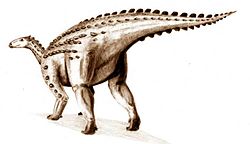Top Qs
Timeline
Chat
Perspective
1859 in paleontology
From Wikipedia, the free encyclopedia
Remove ads
Paleontology or palaeontology is the study of prehistoric life forms on Earth through the examination of plant and animal fossils.[1] This includes the study of body fossils, tracks (ichnites), burrows, cast-off parts, fossilised feces (coprolites), palynomorphs and chemical residues. Because humans have encountered fossils for millennia, paleontology has a long history both before and after becoming formalized as a science. This article records significant discoveries and events related to paleontology that occurred or were published in the year 1859.
Remove ads
Plants
Angiosperms
Dinosaurs
New taxa
Remove ads
Pterosaurs
- Buckman described a clutch of 4.5 cm long oval-shaped fossil eggs from Middle Jurassic marine rock in the United Kingdom. He erected the new oogenus and oospecies Oolithes bathonicae for them, the first time fossil eggs had been given their own unique taxonomic name.[5]
New taxa
Synapsids
Non-mammalian
References
Wikiwand - on
Seamless Wikipedia browsing. On steroids.
Remove ads


